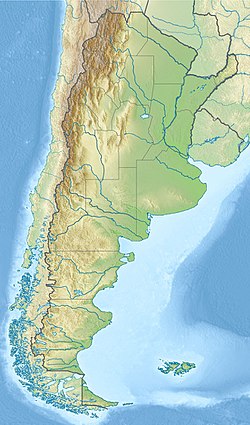Top Qs
Timeline
Chat
Perspective
Chorrillo Formation
Geologic formation in Patagonia, Argentina From Wikipedia, the free encyclopedia
Remove ads
The Chorrillo Formation, also named as Chorillo Formation,[1] is a Maastrichtian (Late Cretaceous Epoch, 72.1–66 million years ago) geologic formation in southern Patagonia, Argentina. The formation is more than 50 metres (160 ft) thick and underlies the Calafate Formation and rests on top of the La Irene Formation.[2][3] It constitutes a significant uppermost Cretaceous continental sedimentary sequence within the Magallanes Basin, located in Santa Cruz Province, Argentina, approximately 30 km southwest of El Calafate. Initial investigations in the 1990s laid the groundwork, with detailed paleontological studies emerging since 2019, revealing a rich biotic assemblage.[4] The formation correlates with the lower Dorotea Formation in Chile, sharing dinosaurian ecotypes, while both are clearly different from other northern Patagonian Maastrichtian units (e.g., Allen Formation, Los Alamitos Formation), which are dominated by saltasaurine sauropods and abelisaurids, suggesting potential temporal or environmental distinctions.[3][4]
Remove ads
Geology
The Chorrillo Formation is embedded within the foreland Magallanes Basin, shaped by Late Cretaceous Andean orogeny driven by subduction along the Pacific margin. Tectonic subsidence, coupled with sediment supply from the rising Patagonian Andes, facilitated deposition.[4] Lithologically, the unit comprises fine- to coarse-grained clastics: mudstones and siltstones dominate floodplain facies, often organic-rich and pedogenically modified; sandstones, arkosic to lithic, form channel fills with cross-bedding; and conglomerates appear as basal lags.[5] Clay mineralogy is dominated by smectite, with minor illite and kaolinite, reflecting volcanic ash alteration. Sedimentologically, it records a meandering fluvial system on a distal floodplain, featuring fining-upward channel sequences, crevasse splays, and overbank deposits.[3] High-frequency paleosol stacking indicates local hydrologic and topographic variability, while low-frequency patterns suggest avulsion-driven progradation. Regional ties extend to the Dorotea Formation in Chile, reflecting basin-wide tectonic influences.[5]
Remove ads
Paleoenvironment
Summarize
Perspective

Paleoenvironmental reconstructions indicate a temperate-warm, seasonally humid climate with mean annual temperatures of 10-18°C and precipitation of 900-1500 mm, inferred from paleosols, clay mineralogy, and biotic indicators.[6] Depositional settings encompass low-energy fluvial floodplains with paludal and lacustrine elements, marked by poor drainage, hydromorphic paleosols (e.g., vertisols, histosols), and redoximorphic features such as mottling and iron nodules, suggesting fluctuating water tables and episodic anoxia.[5] Aquatic communities feature Nymphaeaceae, Salviniaceae, Salviniaceae, and Zygnemataceae, indicative of freshwater ponds and swamps, while terrestrial elements include conifers, ferns, and angiosperms in riparian zones.[7] Floral phytozones, derived from palynological data, comprise five assemblages across the section, exhibiting quantitative variations in taxa proportions without major turnover: lower zones are fern-dominated (e.g., Cyatheaceae), transitioning to angiosperm-rich upper zones (e.g., Proteaceae, Nothofagidites), attributed to subtle humidity fluctuations or habitat gradients relative to fluvial channels.[8] These patterns align with Maastrichtian assemblages in southern Gondwanan basins (e.g., La Anita, Lefipán Formation), reflecting angiosperm diversification and Weddellian Province expansion.[3][8]
Remove ads
Fossils
Summarize
Perspective
Dinosaur remains are among the fossils that have been recovered from the formation.
Fossils recovered from the formation are:
Color key
|
Notes Uncertain or tentative taxa are in small text; |
Arthropoda
Decapoda
Insects
Molluscs
Gastropods
Bivalves
Color key
|
Notes Uncertain or tentative taxa are in small text; |
Fishes
Amphibians
Plesiosaurs
Lepidosaurs
Color key
|
Notes Uncertain or tentative taxa are in small text; |
Mosasaurs
Rhynchocephalian
Snakes
Turtles
Archosaurs
Crocodylomorphs
Ornithischians
Sauropods
Theropods
Mammals
Remove ads
Flora
Color key
|
Notes Uncertain or tentative taxa are in small text; |
Algae
Liverworts
Hornworts
Lycopods
Ferns
Non-conifer Seed Plants
Conifers
Magnoliids
Monocots
Eudicots
Remove ads
See also
References
Wikiwand - on
Seamless Wikipedia browsing. On steroids.
Remove ads
































